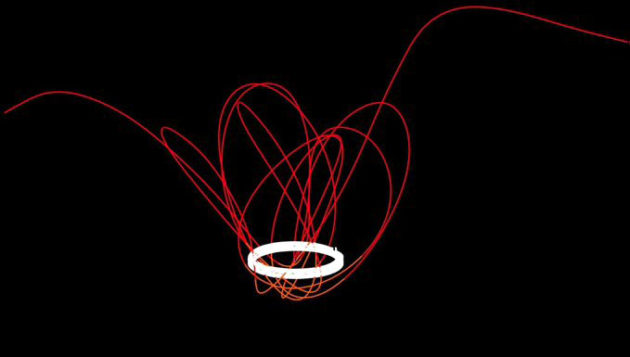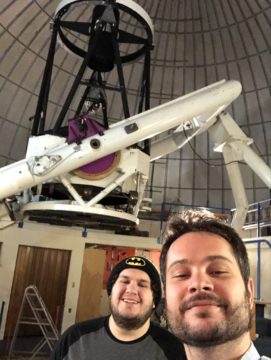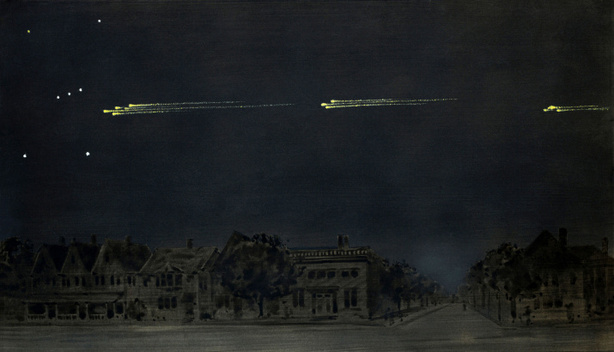Two astronomers have discovered a temporary mini-moon captured by Earth.

Catalina Sky Survey, University of Arizona
When no one was looking, Earth took on a brand new moon. Known as 2020 CD3, it was discovered on February 15th by Catalina Sky Survey (CSS) astronomers Kacper Wierzchos and Teddy Pruyne. At the time, the object was a 20th-magnitude pinpoint 300,000 kilometers from Earth in Virgo. Combining brightness and distance information, astronomers estimated the asteroid's diameter at 6 to 12 feet (2 to 3.5 meters) across, or about as wide as an elephant is tall.
Follow-up observations from one of the Catalina survey’s telescopes on top of Mt. Lemmon, as well as additional measurements from observatories in the U.S. and Europe, soon revealed that the space rock wasn't orbiting the Sun. Instead, it's circling Earth, though only temporarily. Working the orbit backwards, astronomers concluded that Earth's gravity had snared the object sometime in 2016 or 2017, making it a temporary mini-moon.
Before its capture, the object likely moved slowly relative to Earth and orbited only slightly farther from the Sun, both factors that assisted in its capture. The asteroid went undetected for so long because it's tiny — and therefore faint — and it orbits our planet in meandering loops of varying eccentricity and inclination.

For the moment, Earth and Mars are tied at two moons apiece, but our sojourn with 2020 CD3 will be brief. Earth will likely ease the space boulder back into its default solar orbit sometime this April and return to its monogamous lifestyle.
Tom Ruen
Early in the discovery phase, there was talk that 2020 CD3 could potentially be a discarded rocket booster, but careful analysis of the orbital data and spectra revealed a distinguishing feature: the mini-moon was little affected by solar radiation pressure, the force exerted by sunlight on objects in space. This indicates a dense, compact object like a rocky asteroid instead of a more cavernous hunk of space junk.
As with any Earth-approaching asteroid, there's always a small probability that it can come back to bite us — but that won't happen this time around. As the mini-moon eases out of the Earth-Moon system over the next two months and resumes an orbit around the Sun, there's no danger of a collision.

Wierzchos / Pruyne
An analysis from the Jet Propulsion Laboratory’s Sentry project indicates about a 3% probability of an impact within the next century. More observations to refine the object's orbit will likely whittle down the impact threat considerably, as often happens with Earth-approaching asteroids.
What the future will bring for 2020 CD3 is anyone's guess. Possibilities include additional re-captures and ejections, or even an impact. Should it collide with Earth, we'll be spared. Objects its size typically fragment when they strike the atmosphere. At worst, it would land as a small meteorite.
2020 CD3 isn't Earth's first mini-moon. In 2006, Catalina Sky Survey astronomer Eric Christensen discovered 2006 RH120, which also strayed near Earth. Like the current mini-moon, it was captured by Earth's gravity and dawdled in our neighborhood for about a year before getting the boot.

Gustav Hahn / Public domain
Both 2006 RH120 and 2020 CD3 likely represent only a small fraction of the parade of captured-and-released mini-moons that have waltzed with Earth since our planet's youth. Some astronomers suspect that the extraordinary meteor display of February 9, 1913, which featured a slow procession of fireballs visible from Saskatchewan to Bermuda, may have been caused by the breakup of a former mini-moon.
Further study of the two known mini-moons will hopefully point us to more. Perhaps by the time the next one drifts our way, we'll be able to target it with a dedicated space mission to gather in-situ measurements and rock samples. After all, you don't have to travel far to get there.
On the lighter side, amateur astronomer David Branchflower (@DavidBflower) conducted a recent survey asking people to vote for their favorite nickname for the object. 464 people participated and picked "Mini-Moo" as their favorite with "Moon 2" a distant second.
2020 CD3 is fading rapidly (now 23rd magnitude) as it inches across Boötes this month. On March 11–12, the waning gibbous moon, or should I say Moon 1, will join its sibling in a distant conjunction about 40° to the south in Virgo. Earth's recently christened natural satellite may not be bright enough to dazzle the eyes or inspire romantic poetry, but we can at least look up for the moment and imagine two moons wheeling around up there. Do it soon though!
 13
13









Comments
KenWD0ELQ
March 2, 2020 at 5:24 pm
So, does this mean that the Earth is not really a planet? Because it seems that the Earth has not "cleared its orbit" of other objects, the same complaint the IAU had about poor Pluto.
You must be logged in to post a comment.
Bob KingPost Author
March 2, 2020 at 10:11 pm
Hi Ken,
I catch your drift. You make an excellent point 🙂
You must be logged in to post a comment.
Steve Smith
March 6, 2020 at 5:56 pm
Jupiter has the Trojan asteroids, so is that not a planet also?
You must be logged in to post a comment.
Rathgic
March 7, 2020 at 10:24 am
there is nothing about this article that is "excellent" It is about a meaningless literally minute particle near the earth so what??????????????????????
You must be logged in to post a comment.
Warren-Odom
March 7, 2020 at 5:04 pm
I think the definition is really referring to "clearing its orbit of any other significant objects." I don't think small space rocks like this count -- even if we could see any in Neptune's or Pluto's orbits, which I don't think we can at this point. (But I share your sentiments about Pluto's bum rap.)
You must be logged in to post a comment.
JRoseT
March 9, 2020 at 6:39 am
It’s horrible;first no valentines candy, second no BDay gift and And lastly I just discovered a new moon in my life and I’m already having anxiety separation issues say lovey
You must be logged in to post a comment.
Bob KingPost Author
March 10, 2020 at 5:35 pm
Thanks for the good humor, JRose!
You must be logged in to post a comment.
JRoseT
March 9, 2020 at 6:36 am
I feel ya 2 like dang...identity crisis but yep tear
You must be logged in to post a comment.
Rathgic
March 7, 2020 at 10:46 am
If you spent more than $5 on this search, in my view it is obvious that you waste a lot of time and money. More importantly, it is a common fault within the astronomy community.
Does it really matter what is happening 100's of light years away and that speculating on what "might be an explaination" is of any value what so ever. Take Black Holes. Initially, it was referred to as "possibly existing" and the went on to explain "if it means what we are speculating it means" then there was no end to what then has come from the astronomy community. And when they see the same thing they saw before now it is said ANOTHER BLACK HOLE HAS BEEN FOUND. But other than the same "data" type appearing there has been no additional evidence as to what it means that would change what "might be" (or might not be) to anything other than another example like this one of huge resources being spent and human lives being preoccupied with meaningless speculations that EVEN IF WE KNEW EXACTLY WHAT WAS GOING TO HAPPEN 100'S OF LIGHT YEARS AWAY one could only say.......So what? At least that is my view after practicing law for 40 years, in private practice, as city prosecutor and Deputy County Attorney and with 82 years of wrinkles in my face.
Of course what you do is harmless, but what is not harmless is your failure to learn and use RATIONAL THOUGHT, which is dealing with the real world THAT YOU MUST DEAL WITH, NOT THAT IS 100 LIGHT YEARS AWAY, but in real terms of trying to understand what IS NOT WHAT MIGHT BE .... BECAUSE REALITY IS 100% CONSISTENT. Same elements.... same result everytime. There is nothing "might" or maybe" about it. And it will merge with that which it can including what we humans do (in the exercise of our free will, which is the exact opposite..... two humans can do the exact opposite in the same situation JUST BECAUSE THEY CHOOSE TO .... except for one thing, when ever what we do merges with reality, it will merge into a result REQUIRED BY REALITY'S 100% CONSISTENCY NOT by what we choose to try and merge with it ie; quite possibly 2 human free will objectives that are the exact opposite of each other ..... AND OBVIOUSLY BOTH CAN NOT PREVAIL.
You must be logged in to post a comment.
Warren-Odom
March 7, 2020 at 5:12 pm
Studying far-off objects helps us understand how the universe works, and sometimes can have unforeseen practical benefits. But this space rock, far from being 100 light-years away is more like 0.00000004 light-years. This research scans the skies for ANY near-earth object that might hit us and possibly cause tremendous damage, so that if needed we can deploy countermeasures. THAT is true in-your-face reality -- and worth every penny.
You must be logged in to post a comment.
JRoseT
March 9, 2020 at 6:34 am
Who left it don’t FEEL right...I like your point and the zenith of reality is attuned to a triangle based on perspective I can agree I hope you feel like I do and common ground will be found to better our lives Thank you and keep searching those free open skies sojourner
You must be logged in to post a comment.
Ludovicus
March 17, 2020 at 12:29 am
Not that I wish to drag this one out, but the quest for knowledge has always been at the center of the human condition. If you look at what we have learned, and what we still do not know, not only about the nature of the universe, but also the nature of ourselves. These things are intimately joined.
If one wants to go to the waste of money, just look at the huge capital spent on the US justice system! It is so convoluted and does not solve the issues, since crime continues to go up, and nothing really gets fixed per se.
If we want to REALLY change humanity and the human condition, doing activities like this (astronomy/astrophysics) brings people together, in search of new knowledge, about why we are here, what's out there, and much more. This is done by many countries, cooperating in peace, and sharing data and theories to refine our understanding in general. What more noble cause could we participate in that learning and sharing with all?
I think your time spent engulfed in the legal system has jaded you and I wonder honestly why you chose to post here other than to get attention at this point. BTW, "free" will is an illusion to a large extent. Sorry to say...
I'd like to see us work towards a future where the endeavor for our civilization has the ultimate goal of empowering all to become the best they can be. Only then can we truly move to a future where the universe is at our fingertips, and the future is bright.
Neat to know we have a temporary little moon! It's amazing that objects this small and dim can be seen so well today... technology is amazing!
You must be logged in to post a comment.
JRoseT
March 9, 2020 at 6:25 am
If we can see feel and observe the mini objects enforces in our world that exist in the universe and understand how they all relatively harmoniously or chaotically work together or against each other we can better navigate not only our solar system galaxy or universe but the temporal existence of our own Emotions thoughts and actions which must manifest through whatever means the world in which we exist SMALL AS QUANTUMELY POSSIBLE OR LARGE AS INFINITELY POSSIBLE for the NOW and better situated ourselves for the possible algorithmic future 143 y’all. I believe itty bitty short life in the city’s an awesome hElophint name pore da widdle guy or gal...widdle wabbit
You must be logged in to post a comment.
You must be logged in to post a comment.